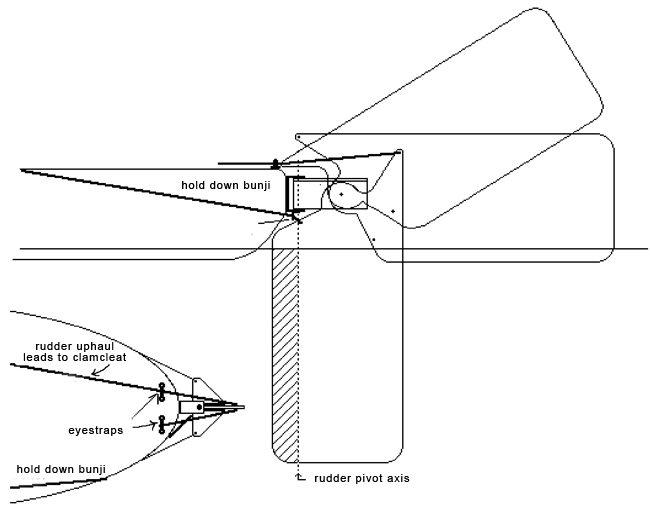PRODUCT DETAILS: Kayak Rudder
Setting up a semi-balanced rudder for your kayak:
The sketch below is of a semi-balanced rudder blade for a sailing sea kayak. The one pictured is for a rudder head such as is used on the Northwest Kayaks. Adapt as needed for your rudder. The idea is to get up to, but no more than, 20% of the swept area of the blade forward of the vertical pivot axis of the rudder. This balanced area uses the water pressure from the movement of the rudder through the water to help turn the blade. This allows you to use a larger blade for sailing without needing excessive pressure on the steering to turn the rudder, particularly at higher speeds. I use 20% balance and do not feel that I loose too much feel. The more balance, the less rudder feedback you feel in your feet. If you go much over 20% the blade will turn all the way to one side and lock until you slow down. Another advantage of a semi-balance rudder is that you can use the rudder as part of the lateral plane of the boat without inducing too much pressure into the
steering system. This allows greater flexibility in the placement of the center of effort
of the rig in relation to the leeboard. In other works, if the center of effort of the
sail plan is too far aft of the center of resistance of the leeboard, the rudder
may serve as part of the lateral plane of the boat without excessive
adverse effect on the steering.
The hold down bunji ties to a piece of light line that leads to a clamcleat. The bunji adsorbs shock if your rudder hits a solid object and allows you to adjust hold down tension.
With Northwest Kayaks rudder, hang bracket upside down and use the uphaul lead for the hold down bunji.
Locate the downhaul bunji hole in the
location that will pull down when the rudder is up. Be sure to deburr the edges of the hole.
The shaded area is 20% of the area of the blade in the water and is forward of the vertical turning or pivot axis.
The size of part of the sailing blade in the water is approximately 7.5” wide by 13” deep.
This is the size I use. It may be larger than it needs to be but I have never found it to be too small for conditions. I have sailed a single kayak at 12-14 knots with this type of rudder.
I use a downhaul bunji to hold my rudder down at high speeds. If a semi-balanced rudder kicks partway up it looses its balance area. A large blade that isn’t balanced is hard to turn at high speeds. I suggest that you rig the downhaul bunji as follows. A shock cord is knotted and led through the hole in the rudder and then forward about half way to the cockpit. It should be connected to a piece of rope, and the rope should be led forward to a clamcleat near the cockpit. This will allow you to adjust the downhaul pressure for heavy winds and to lighten it up for easier uphaul in lighter winds. If you rig your rudder uphaul as drawn above you will have two to one purchase. This will allow you to pull up the rudder easily even with a lot of tension on the hold down bunji. The uphaul dead ends at one eyestrap, goes through a hole in the rudder, through the other eyestrap and to the cleat.
If someone wishes to make themselves a balanced blade for sailing their kayak, we have templates for blades to fit Klepper, Feathercraft or Northwest Kayaks type rudder heads. If you are interested, please ask.












